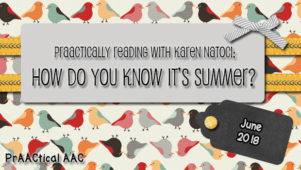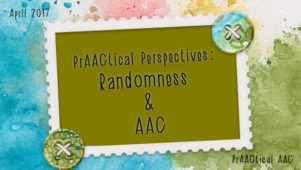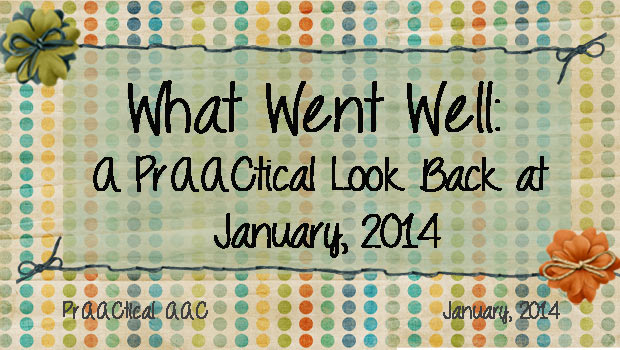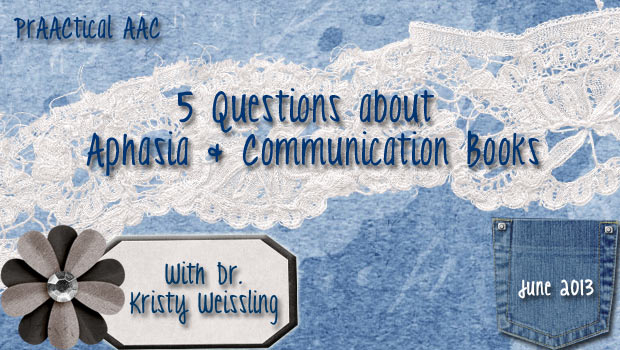AAC Therapy: When the Lesson Plan Fails

We’ve all been there. You have meaningful goals, engaging materials, and a solid lesson plan for our therapy session. Five minutes into the session, it’s clear that the AAC learner has little or no interest in what we’ve prepared. Now what?
Our choices are limited: persevere with the plan, modify it somewhat, or scrap it entirely. What’s a clinician to do?
Take A Breath
The first thing to do is breathe. Know that you are not the first one to struggle to engage this learner, and you won’t be the last. Think of it not as an excuse for an unproductive session but as a problem-solving challenge. Previous clinicians may have justified the session’s difficulties and atttibuted them to the learner’s lack of engagement, limited attention span, or behavioral problems. Personally, I feel sad for those clinicians because when we take that approach, not only do we fail the client, but we fail ourselves. How can we grow and become better at our craft if we see others as the source of the problem? Clinicians like that are limited, and will grow slowly, if at all.
Luckily, we’re not them.

We’re clinicians, not technicians. We’re problem-solvers. We persist. Our wings are beautiful, and flexible, and strong. We can fix this. Real AAC professionals build their wings.
Check The Tone
When things don’t go according to plan, it can be frustrating and scary. If a parent is observing the session, we can feel downright panicky. All of those feelings are normal, but remember this: You’re not the first one to have a difficult session with this learner. You may, however, be the first one to successfully recover and go on to be effective in the session. Trust your wings. You may need to build up their strength or stretch them to adapt and be more flexible, but those are things within your power. Making it our mission to gain more powerful wings is what makes us good SLPs. We build up our wings so that we can trust them when things don’t go according to plan.
While the initial activity seems to be melting down, our internal state may be one of fear, embarrassment, or frustration. It’s natural for those emotions to work their way into our tone of voice, so that’s something to watch out for.
Sometimes we respond by adding enthusiasm. For some learners, become a bit bubblier and boosting the ‘fun factor,’ is all that is needed to help them re-engage with the activity. If so, problem solved. Score one for the wings!
It’s also natural to get a little frustrated, and sometimes we are tempted to respond with a firm tone. Is that ever appropriate? Sure. For some learners, under some conditions, it makes sense to do get a little firm and re-direct them to the planned activity. As long as the tone is ‘firm’ as opposed to one that signals frustration or annoyance, this may be something to try. Once you do, observe the response and ask yourself:
- Was that effective?
- Was it respectful?
- How would I feel if someone talked to me or my child in that way?
Your answers will help you know whether this approach is one to use again in the future.
Persevere with the Plan
Because we worked so hard in developing the plan and our materials, we are generally very tempted to stick with the plan. If we just keep moving forward, we reason, maybe the AAC learner will become more engaged.
Sometimes that makes sense. Many of our AAC learners are highly distractible. These learners can easily get derailed by a distraction by a noise from outside or a toy that they spot in another part of the room. Here’s where knowing your client makes a big difference. For some, you can re-engage them by briefly following their lead and then bringing them back to the lesson you had planned. Often, we can do this successfully by adding a little more enthusiasm, tempting them with parallel play, or using a transition object.
As we do, the learner’s response and our self-reflection help us strengthen our wings.
- Was that effective?
- Was it respectful?
- How would I feel if someone talked to me or my family member in that way?
Make Modifications
Sometimes, making a few changes to the lesson can salvage it as a learning experience. Here are a few examples.
- When it was time to work with a superhero-lover, I was excited to dig out my mega-cool, took-me-3-trips-to-the-fleamarket-to-find-them-all, and-they-cost-me-a-fortune! basket of action figures. Carlos, however, was unimpressed. Clearly, they weren’t going to work for our requesting goal. Luckily, however, he was also working on protesting, and using verbs and descriptors. We reconfigured the activity so that the focus was on throwing them away into a makeshift (pretend) trash can. When we offered each toy to him, he got practice saying, ‘No, thank you,’ (which sure beats screaming and hitting). Then he got to choose HOW we’d discard that toy. Was it going to WALK, JUMP, or DANCE to the trashcan? Should they walk MORE, dance FAST, or do a BIG jump? He had a blast directing our actions and watching the silly things that Spiderman, Catwoman, and the others did. Whew! Another point for strong and flexible wings.
- I needed to get a sense of Jamie’s inferencing skills and although the photos we brought for the session seemed interesting to this teenager, she clearly wasn’t into telling us what might have led to the actions in each photo. It was too much work! We modified the activity using a hastily-drawn rating scale: 1=definitely not, 3=maybe, 5=definitely. Then we gave her 3-4 options for each photo that were plausible inferences (e.g., It happened because….Something broke; Someone was mean to him/her; She didn’t know what to do). She rated them using our scale without any hesitation because the (re-tooled) task was less work on her part. And because the goal was to gain insight into her inferencing skills, we could live with her only pointing to a number on the scale (as opposed to creating a sentence or two with her AAC device). Our well-developed wings saved us again.
Scrap the Plan
A good captain knows when it is time to abandon ship. Sometimes, the best way to our destination is to jump off, get our crew to a lifeboat, and start rowing. To do that, though, we need a lifeboat.
Lifeboat # 1: Follow the learner’s lead. What is it that they seem interested in at the moment? Consider how you can use that to achieve some of your original therapy objectives. I might join a client who runs to the window when she hears the trash truck so I can map (aided) language onto the experience. “Look! I want to see. What are they doing? Helping. Cleaning up. Picking up. Putting down.” On a good day, I can extend the experience by taking some pictures with a phone or tablet, making them into a story, building a vocabulary collage, or just using it to tell mom what we saw using AAC.
Lifeboat # 2: Have some back-up activities planned. For many clients, this is a lifesaver. Plan out two or three activities that you hope never to need in your sessions but can implement at a moment’s notice. In my experience, it is WELL worth the time and effort to prepare these and lug the materials around.
All The Feels
There is no shame in a lesson that doesn’t work well. It happens. A bad experience is only a bad experience, not a tragedy worthy of heart-stopping emotion. It can become disastrous, though, if we don’t take steps to rectify things for future sessions.
Still…It is hard. It is no fun having a difficult session, but it happens. Look, if these learners were easy to figure out and help, they may not have gotten to us in the first place, right? While it is natural to feel embarrassed if something doesn’t go well, try not to let that lead to shame. Shame is a dangerous emotion, and rarely leads to productive solutions. One way to keep an embarrassing or frustrating experience from devolving into shame is by owning it. Name it in a way that works for your personality and therapy style. Shed light on it directly, with humor, or casually…whatever is a good fit for you.
But we don’t stop there.
Then we reach out to the family or other stakeholders to: a) get their input and suggestions for upcoming sessions, and b) share our own plans for how to avoid or minimize these issues in the future. When a family member or colleague is participating in a session or observing, it is natural to want to avoid discussing any problems in the lesson. Hiding it leads to shame, though, and not much good comes from that. Most parents respect an SLP who initiates frank discussion when problems occur, and that only grows when the clinician partners with the family to strategize solutions.
Evaluate the Session
When we have a rough session, there is strong motivation to avoid a repeat performance. Taking the time to reflect on the session can help in this regard.
- What caused the issue? Is there anything I can do to minimize the chances of it happening next time?
- Does it need more structure?
- Would more visual supports help?
- Are there additional strategies I can try?
- What worked well? (Don’t skip this one!) Why was that successful? What can I do to exploit that success?
Finding the Keys
There are two keys to rescuing an unsuccessful lesson plan. The first is to keep working on those wings. Do what you can to strengthen your clinical skills and become as flexible as possible. Keep reading. Talk to other clinicians, especially those who seem effective and successful. Partner with families and teachers who know the learner. Watch webinars. Develop your online Professional Learning Network through Facebook groups, Twitter hashtags (#augcomm; #SLPeeps; #AssistiveTech). See if you can observe other therapists or ask to watch a family do an activity with the learner. Go to conferences and workshops that address topics of interest. There are lots of ways that we help our wings grow stronger and more flexible. Do it in whatever way works for you.
The second key is to stay focused on the goals, not the activities. When you spend an hour preparing the materials for an activity (thank you, Pinterest and TeachersPayTeachers!), it hurts when the client doesn’t love it as much as you do. But with strong wings, you can address your learner’s goals in a variety of ways. Commit to the goals, not the activity.
Decent clinicians have fun, engaging activities. Good clinicians are skilled in intervention strategies. Great clinicians stay focused on the goals, and use their wings to adapt. Let’s keep flying!
Filed under: PrAACtical Thinking
Tagged With: AAC Therapy, lesson plan, self-improvement, self-reflection
This post was written by Carole Zangari





2 Comments
This article resonates with me , and I am sharing it with my graduate clinician. It acknowledges the constant problem solving we need to do….no matter how experienced or creative you are. Take a step back and reset. I will be making my 2-3 fall back activities ! (33 years experience !)
Thanks for taking the time to comment, Andrea. Taking a step back to reconsider is something that I’ve done more times than I can count. Sigh. Like you said, no matter how creative or experienced someone is, it can help to get a new perespective, and have a few extra activities planned.